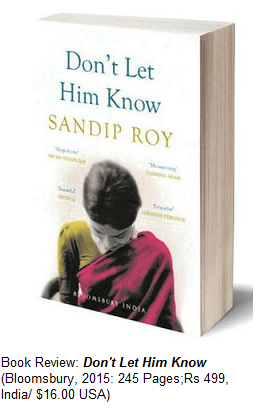‘Don’t Let Him Know’: Sandip Roy’s Absorbing Novel On The Fragile Edifice of Family Life
By Pritam Bhowmick
 If a woman’s heart is an ocean of secrets, Sandip Roy’s formidable debut novel, Don’t Let Him Know, tells of how a man’s can also be subjected to the same conspiracy of silence be it that of parent, spouse or descendent. For in between the crevices of these compartmentalised identities/roles, lie aspirations dashed, neglected affections long suppressed, and percolating wants buzzing ceaselessly. Memories of these often recur in patterns to disrupt the safety of the comfortable’ truth’ that masquerades as family history.
If a woman’s heart is an ocean of secrets, Sandip Roy’s formidable debut novel, Don’t Let Him Know, tells of how a man’s can also be subjected to the same conspiracy of silence be it that of parent, spouse or descendent. For in between the crevices of these compartmentalised identities/roles, lie aspirations dashed, neglected affections long suppressed, and percolating wants buzzing ceaselessly. Memories of these often recur in patterns to disrupt the safety of the comfortable’ truth’ that masquerades as family history.
Roy’s narrative centres on the Mitra family, Amit, his American wife, June, and recently widowed Romola who has come to live with her son and daughter-in-law in America. Romola’s deceased husband, Avinash looms as a shadow over all of them, his story revealed through letters and memories. The ‘novel,’ which is put together as a succession of stand-alone of narratives or short-stories, form a grid of crosshatching temporalities.
Roy reveals that Romola and her husband Avinash, are both custodian and captive of individual secrets, which relate to their suppressed desires. For Romola it is a longing for a matinee idol; for Avinash, a proclivity for certain men, including a family friend. Characteristic of their class and generation, the affairs of Amit’s parents are largely consummated only in their minds, able as they are, only to express themselves in the longing looks that accompany poignant and searching silences. Avinash is bolder but we are left feeling the dire consequences of his recklessness in a cruising encounter gone wrong.
While pleading with the guard to catch a glimpse of Subir’s dead body, Romola, in a dizzying fit realises her own sacrifice in facilitating the transformation of her would be paramour, the pot-bellied Subir Lahiri, into the dashing film idol, Subir Kumar. The Bael flowers Subir had so admiringly noticed in her hair many a moons ago in a socialite party become the final deposit on behalf of a woman at his funeral bed, who had made it there in torn sandals through barriers of smoke and dust, only to tuck away his letters to her in the folds of a Tanjore saree she never wore.
Roy gives us many such indelible images, and demonstrates his adeptness in placing the reader in a particular time and place. This quality is well exemplified in the following passage in which Romola enters Avinash’s apartment in the USA for the first time:
“The apartment smelled of trapped air and stale food. ‘I should have left a window open,’ he said apologetically. Romola said nothing. On a dining table she could see and old overripe banana in a fruit basket, its yellow skin blotched with black leopard spots. She could almost taste that banana from the front door – its rich coying smell pooling around her stickily. She suddenly lost her appetite.
The sights and smells in particular are vividly rendered, and the reader too is left tasting that overripe banana. Such clarity of image and experience are peppered throughout the narrative, and demonstrate Roy’s strengths as a story-teller.
Roy explores taboo themes seldom touched in Indian Diaspora writing. Avinash’s fascination with the male anatomy, for instance, being rooted in childhood days from an encounter with an intoxicated Muslim gold-chain wearing barber. Unable to express his desires, he is sent underground to the world of Internet dating, leading him to be lured to a shady encounter in a a desolate park with a young man named Rohit. He is almost destined to relive childhood trauma and shame when he is overpowered and forced into a sexual act with the younger man, who extorts him for money, afterwards. The bruise he gets on his knee from this encounter serves as mark of transgression outside the domicile, the contours of hetero normative expectation. Roy never shies away from complexity. Remarking on Avinash’s reaction, he writes, ‘there was a strange erotic reassurance in the pain’. It is at least a physical sensation, for his relationship withSumit and his abdication could not transcend to touch. and Sumit’s letter voices his disappointment with Avinash for not having ‘waited ‘ for him, getting married instead. The content of this letter shatters Romola’s world ‘like a hammer’, and she is left questioning her whole life, as a result.
Time and time again, all complacency in fate’s machinations and over-turnings are taken apart in a masochistic deferral of arrangements and plans. The narratives contain images of lucidity and exactitude, as they proffer insight into the tumultuous lives caught in between home and home abroad, of evolving patterns, food habits et al. The flux of an endless retinue of novelties, objects at the supermarket, news of gossip to be circulated among relatives in Calcutta takes the reader into the recesses of especially Romola and Avinash’s psyches as they fumble for a lexicon to appropriate the disjunctions plaguing their lives. Here, the incoherence of these is commendably not represented just from the perspective of a diasporic cross-sectional lens.
The fissure on the ceiling wall at Avinash’s place emerges into cognizance only at the time of his death, a reminder of unbendable wounds and the need for filial comfort. It is in many ways an achievement of this work to have borne testimony to the incommunicado that creeps in between mother and son as the latter keeps sauntering away from articulating if his mother would like to move in with them to California. What of the endangering of his sex-life with his wife, June? And ‘why.. pretend that she does not exist?’, he ruminates. The unacknowledged is more than a trope here, often swerving into the daily modes of preoccupations and trivialities, making conspicuous the absent, the excised, but never forgotten.
The book is a well told and complex portrait of family life and the fragile architecture around it. With humour and poignancy, Roy manages to depict itchy discomfort of life beneath the neat layers of living, whether in India or America. In the end, Roy may well be saying that satisfaction can be found in the most unlikely of places and with the most unlikely of companions just as Romola finds comfort in opening up to a transgendered dancer in an alcohol induced encounter at a bar in Carbondale. She is left to face the wrath of her worried son upon her return but the encounter makes her at ease with her burdens and she drops her blue anti-depressants out the window on the drive back to San Francsisco. This may be meant to tie a narrative knot. In the first story, she has an encounter at MacDonalds that sees her running away with a Big Mac in hand. As she bites into the forbidden meat, her white widow’s sari gets stained red with ketchup. In the last story, she lets loose little blue pills, literally letting go of her sadness (ironically by tossing her anti-depressants out of a car window) as they drive from her old home as a new wife in Carbondale to her new one as a widow in San Francsico. It brings closure but but might seem a little too on the nose.
If there is a major flaw in the book, it is that we are left wanting to know more about the characters around Romola. Amit and June are quite thinly revealed, and while Avinash’s secret, its roots and consequences in his life, are revealed, he remains little more than a ghost. Romola occupies the most narrative space, and is delightfully depicted in her judgments of and reaction to others. We are able to see her from different perspectives at different points, and she becomes strikingly real.
The format of the book is satisfying in many ways but limits the reader in how the characters are revealed. A traditional novelistic structure might have depicted the characters more three dimensionally than they appear in the book as it is written. And, the tension that is built up in the first three chapters / stories by a secret letter vanishes from the narrative as though it had never carried such emotive force. There is a certain loss of momentum: a story arc is built and then left to dangle. The kalaidescopic nature of the the book, allowing the reader to re-encounter the characters at different periods and gaze upon them from different vantage points while interesting and enjoyable, takes away from the larger narrative momentum. So, as a collection of short stories, the book works very well; as a novel, less so.
That said, Don’t Let Him Know is one of the more readable and vivid, books you are likely to read in 2015, especially out of India. Roy’s debut novel takes one from the domestic and familial to the dangerous and outrageous, and does so with style wit and an appreciation of detail that is certainly uncommon. It is a strong work of fiction that will have people looking for those perilously twisted edges of the middle in the lives of the middle class Indian family.
 The Global Calcuttan Magazine
The Global Calcuttan Magazine 